
Owner's Report & Modification Report
Please send me your guitar report!

Owner's Report & Modification
Report
Please
send me your guitar report!
| Mr.OGIRA | ||
|
A prototype of my original tremolo block (sloppy work but the result is ....!!!!)
I've modified my tremolo block to see how my idea would work.
|
| Drew Duncan |
Warmoth Swamp Ash Tele & Custom Amplifier 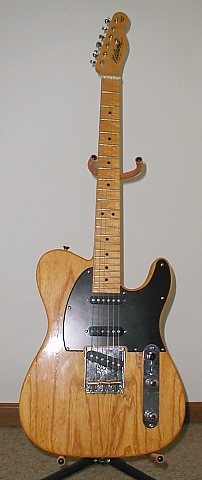  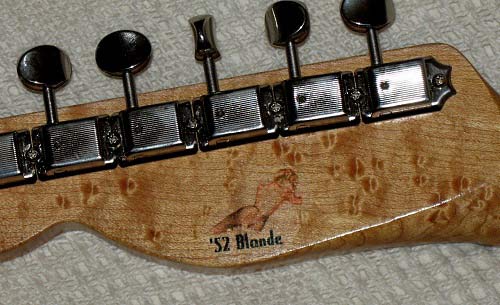 I like this guitar a lot. The neck profile feels very good. It is between thin and thick. It is thicker on top and thinner on bottom (asymmetrical), so it fits to the web of your hand, between thumb and fingers. I used an Earvana nut to allow for better intonation in the lower frets. The pickguard is only one layer of matte black, to resemble bakelite. It has 7 screws. The body is medium light swamp ash. I made a "belly cut" on the back, for comfort. It is finished with about 4 or 5 thin coats of nitrocellulose lacquer. First, the bare wood was tinted with vintage yellow dye. Next, I used Parks brand nitro sanding sealer for wood floors (hard). The second coat was Jet brand furniture lacquer (soft). I left those 2 coats to dry in my woodworking shop for 3 months. The temperature could get both hot and cold. The nitro layers dry at different speeds. The soft layer tried to shrink faster than the sanding sealer, so it started to crack. When it looked old enough, I sprayed on 2 more coats of reranch instrument lacquer (hard) to seal it altogether. I wet sanded with 320, 400, 800 and 1200 grit sandpaper and did a light machine buffing. Not too shiny. It is difficult to see in the pictures, but the body has many thin cracks that look like broken glass. Also the finish on the fretboard is worn through in several areas. It is "lightly reliced". 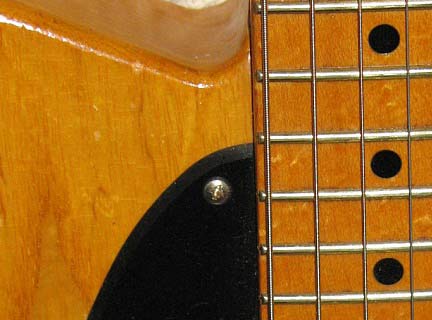 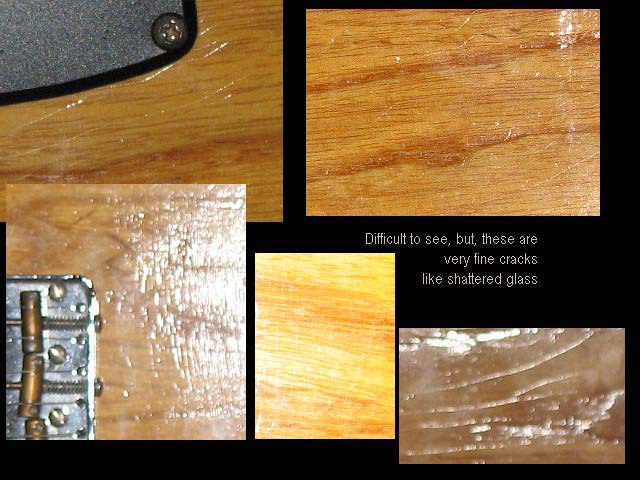 The bridge plate is an old Fender model, but the saddles are new. They are bent a little for better tuning. I used mild acid to make the brass saddles and screws look old.  The Bill Lawrence pickups sound good. No one can guess that they are noise cancelling, because they sound like old single coil pickups. The neck pickup has no cover. It sounds much better than most Tele neck pickups. It has a little bit of Strat tone and works well for jazz and blues. The bridge pickup has more "clang" than "twang", like a Broadcaster. It can sound good clean, but it loves to play loud through an AC30 or similar tube amp. The middle pickup is only on in switch positions 2 and 4 for the Strat out-of-phase sounds. Position 3 (middle) uses both the neck and bridge pickup, like a Tele. It is a "super switch" from Stewmac. It is wired with teflon insulated, audiophile wire, CTS pots and a NOS capacitor. I used this guitar in my booth at NAMM, to demonstrate amplifiers, so many people could try it. Everyone seemed to like it. The best sounds with this guitar are: neck pickup clean (very sweet), neck + bridge pickups together for that classic Tele high/low or hi fi sound or the bridge pickup through a slightly dirty tube amp, which sounds like fire alarm bells and thunder. I have made several custom guitars for testing amps, but this is the best one. Over the years, I have made about 300 tube amplifiers. I specialize in old-style, vintage amps (1948 - 1970). Many of my customers are producers, studio musicians or touring guitarists. I do not advertise, because I already have a backlog of more than a year. I just can not work fast enough. I have included a picture that shows my amp making process. 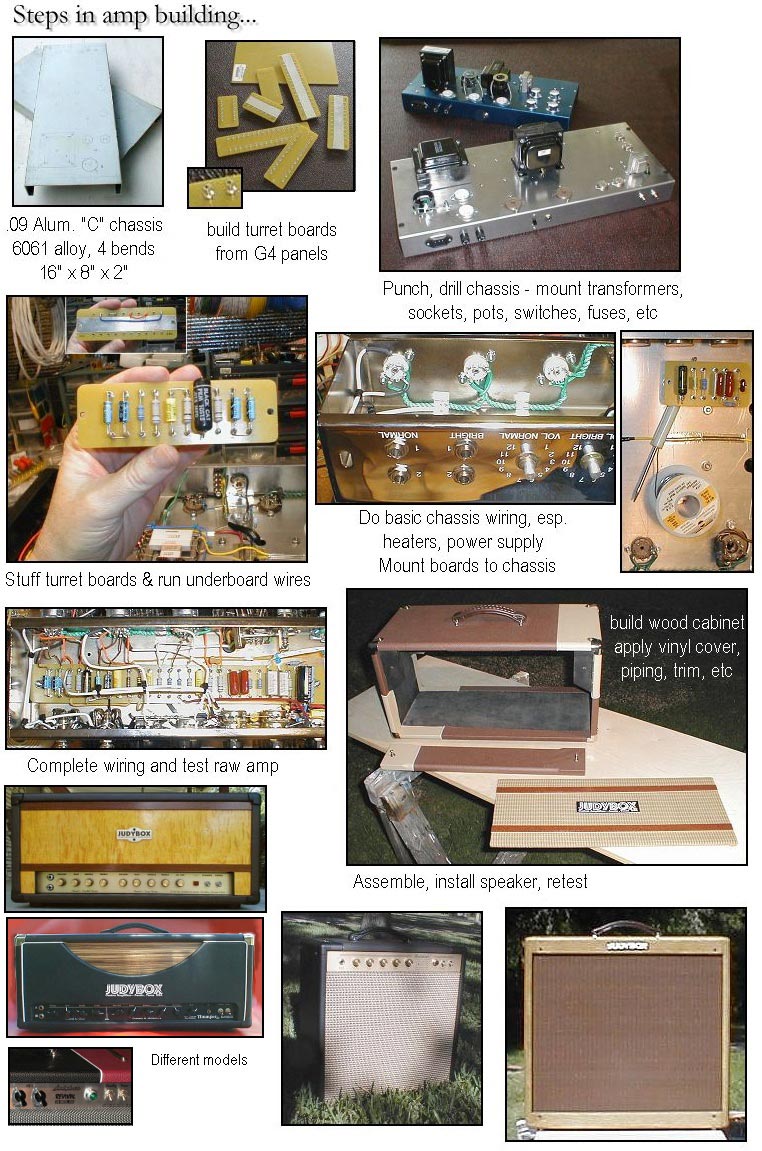
|
| Kabudokan | |
USACG T-Hollow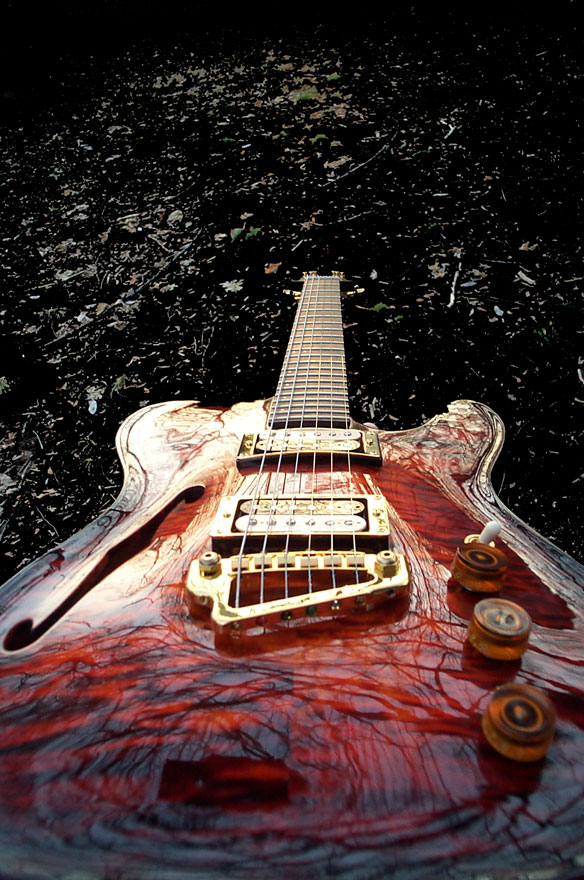 The carved top is wild maple - I spoke with Tommy of USACG about what I wanted, and he picked out the flamey, quilty piece you see there. The back is one piece of mahogany. The top was stained with a dark brownish-red-black, then sanded back. Then stained again, I think with a more reddish color. (It's been a while.) Sanded back again - then I applied the final color, which was the orangish red that was the final color. I then applied a few coats of clear nitro, and then did the burst. The burst was done with the 3- color burst set from reranch. The reddish color is most of it, with the very outer edge coming from the brown-black that goes on the outside of the 3-color burst. Multiple layers of clear topped it off. The back was a combination of amber and the red from the 3-color burst. Also, you can see that I taped a faux binding on the top before I sprayed the burst - it's not a clear, natural binding ala PRS, but gives it almost a tortoise-shell appearance. The water-based stain came from www.wdlockwood.com . I have used their stuff on both of my projects though, and it's very quality stuff, and very reasonably priced as well. The nitro lacquer products (clear and burst colors) all came from reranch, which is also great stuff. I was a bit worried about doing the burst, but it came out great. You can also see most if not all the pictures I took during the finishing process. http://smg.photobucket.com/albums/v519/KaBudokan/ Specifications: Body - USACG T-Hollow Neck - USACG US-4 2pc Brazilian Rosewood Bridge - Hipshot Baby Grand Tuners - Sperzel Sound Lock tuners Nut - Bone nut Pickup - WCR Darkburst and Crossroads Weight - around 6.2 pounds. Sound : It's very versatile, really. It can do a fairly convincing Les Paul tone, though maybe a bit warmer. It also does a great rockabilly tone when you flip to the bridge pickup. I tend to work mostly on the neck pickup (always have), and it gives a full, clear tone with great sustain. When pushing my amp hard (Top Hat Club Deluxe - a 20-watt, single-channel class A amp) I can get controlled feedback on demand depending on how I turn the guitar and let notes ring, etc. It's a beautiful thing!
|
| Southern ILL |
Army green Custom/Deluxe 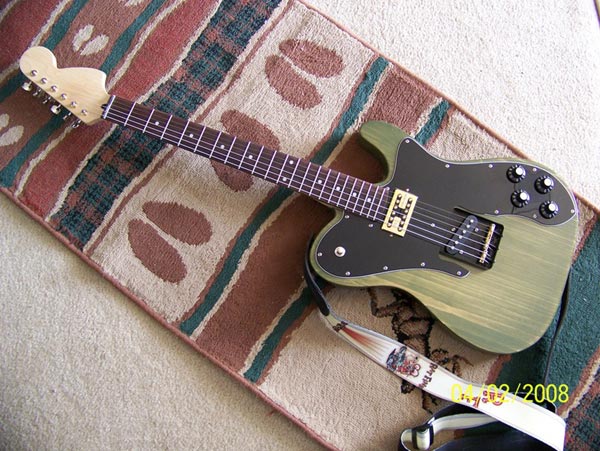 Body is a Guitar Mill Pinecaster Custom-2 pieces and its a lightweight.Total guitar is about 6.5 pounds....Neck is a Mighty Mite with a CBS large headstock.Kluson staggered tuners.Pickups are GFS with a Hot alnico LiverPool in the neck and a 62 Hot Alnico in the Bridge.The bridge and saddles are Wilkison and I can Top Load it or string it through the body. I prefer to Top Load it. Plays really good and tone controls are really active...Roll the tone off and tone get thick.....This guitar turned out better than excpected and I have plans for the next one already....Love this style(Telecaster Custom/Deluxe) and my next build will have different style of pickups..... Finish: Miwax Water base stain(4-5 coats) with a wipe on Poly finish(4-5 coats also). Very thin finish.Was really going for a GI Joe look...... Sound: I'm more of a Rockin' & Roll" guy....and this guitar is very versitle. My heros' are Mike Ness(Social Distortion) Brain Henneman(the Bottle Rockets) Angus and Malcolm of couse-Johnny Cash and Luther Perkins-Rich Robinson(Black Crowes).And this guitar can cover all those great tones. I like it cause its different..Not what would normally come from Fender....and Billy next door doesn't have one. |
| Tyson |
"General Lee" Tele 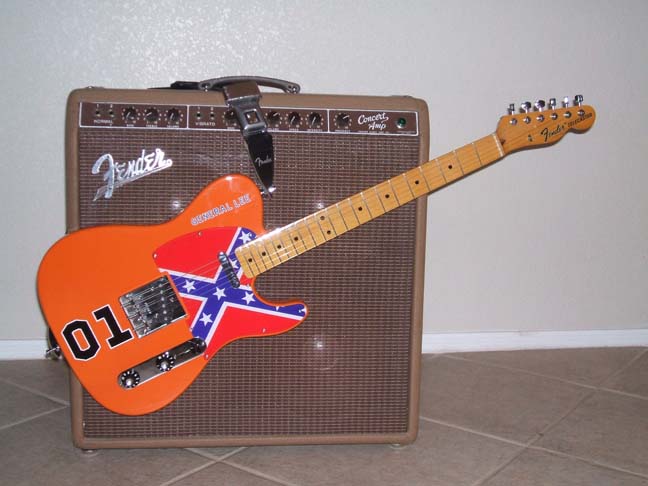 This Guitar is my first build, finished in July 2007. I grew up in the '80s, and the Dukes was my favorite show....the first time I saw a Dixie flag pickguard, the wheels started turning.... I used a Warmoth body from Warmoth's showcase, it was already finished in what the company simply called "Bright Orange." The neck is a modified Allparts piece, finished by Eric at Revelator guitars (THANKS, E!). All hardware is Fender except for the Electrosocket jack, and the pickguard came from Pickguards.com. The control plate has since been reversed to make it easier to access the amp knobs used for volume and tone. The decals were custom made for me by buildagenerallee.com, and are scaled down versions of the same decals that go on replica General Lee cars. I was going for a '69 Telecaster theme, since the "real" General Lee was a '69 Charger. To do this, I used Fender "F" tuners and neckplate, and a bridge with notched steel saddles, just the way they came back then. The pickups are Fender Texas Specials.... I figured a hotrod like this deserved some hot pickups! '65 Mustang - Barbie guitar A friend of mine rescued a '65 Musicmaster neck and an early non contoured Mustang body from a parts box, and had a friend of his finished it in his autobody shop in pink of all colors....so it became a Barbie guitar :-) All new CIJ reissue hardware, and Lace Sensor pickups....gold in the bridge position, blue in the neck. It hangs in my two year old daughter's room, waiting for her to learn to play it!
|
| Chris Baker | ||||||||||||||||||||||||||||||||||||
'59 Slabboard replica This is my '59 Slabboard replica. 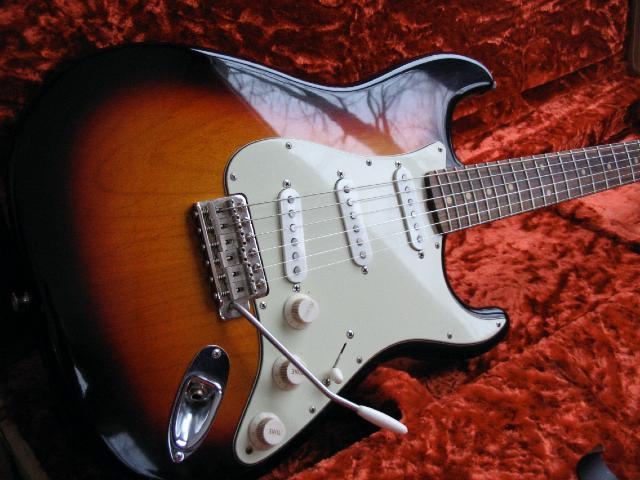 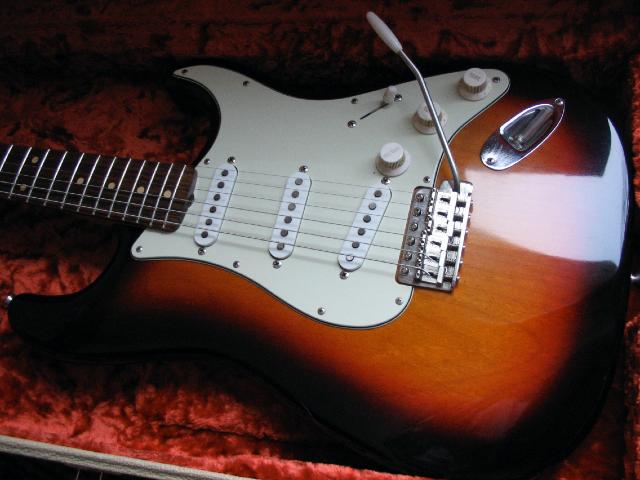 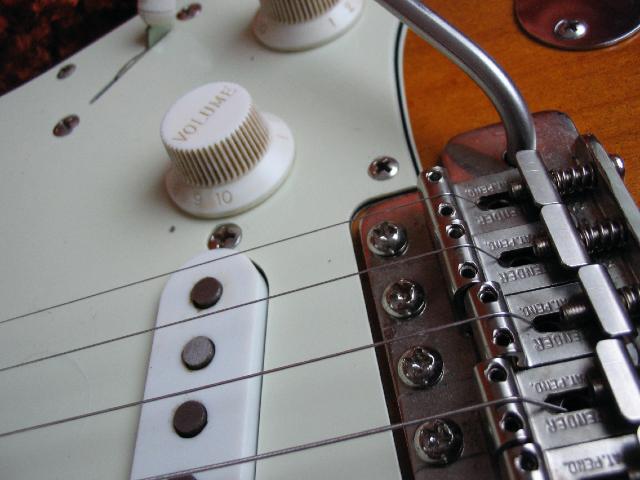 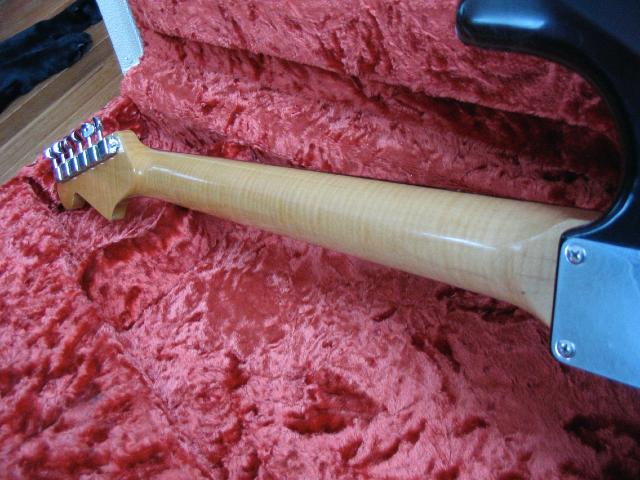 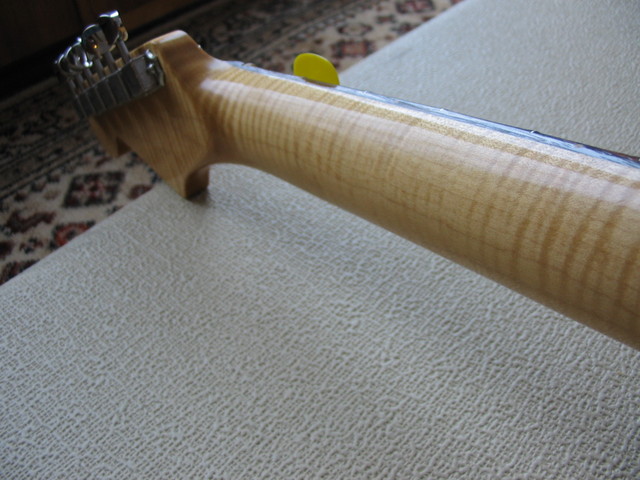 Specifications:
|
| Katsumi | ||||
The Way of Relic - Vintage aged finish projects 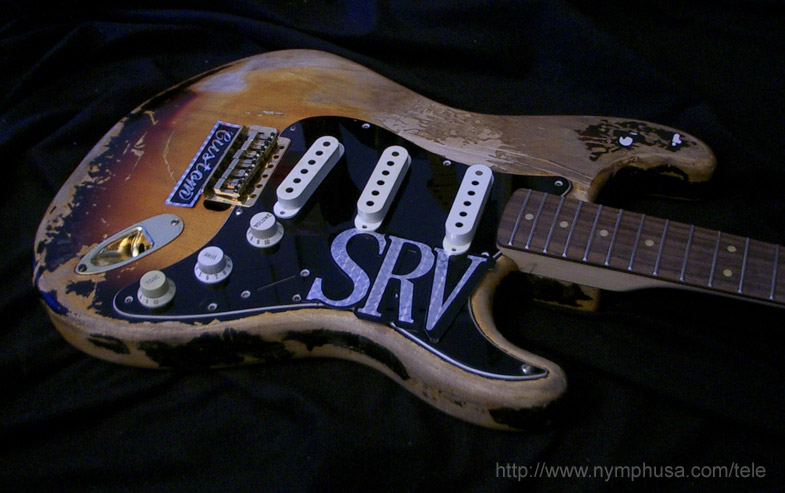 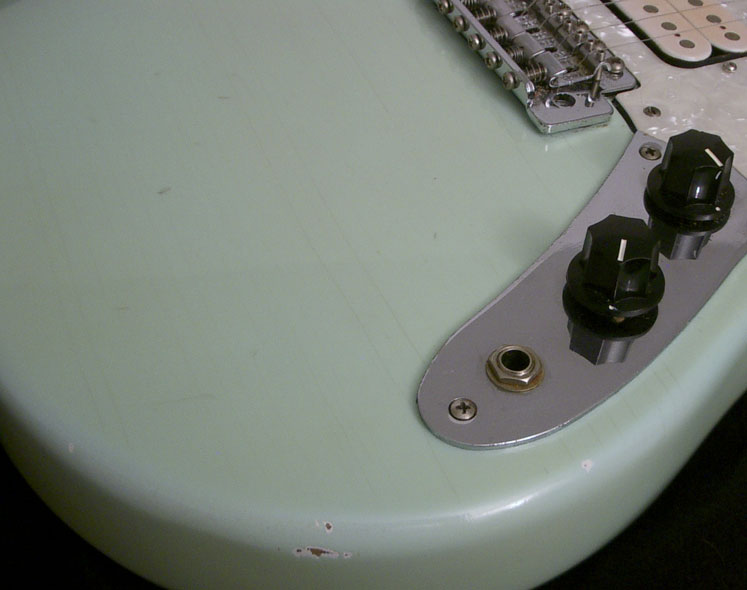 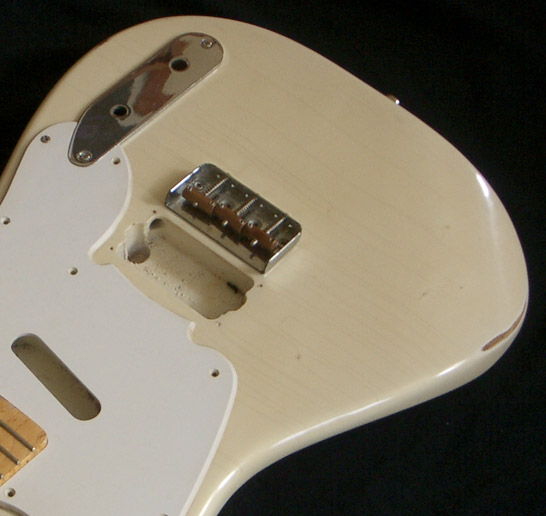
|
| Robin Nahum | |
| Short Scale
Neck with Split Block Inlays Thinline partscaster 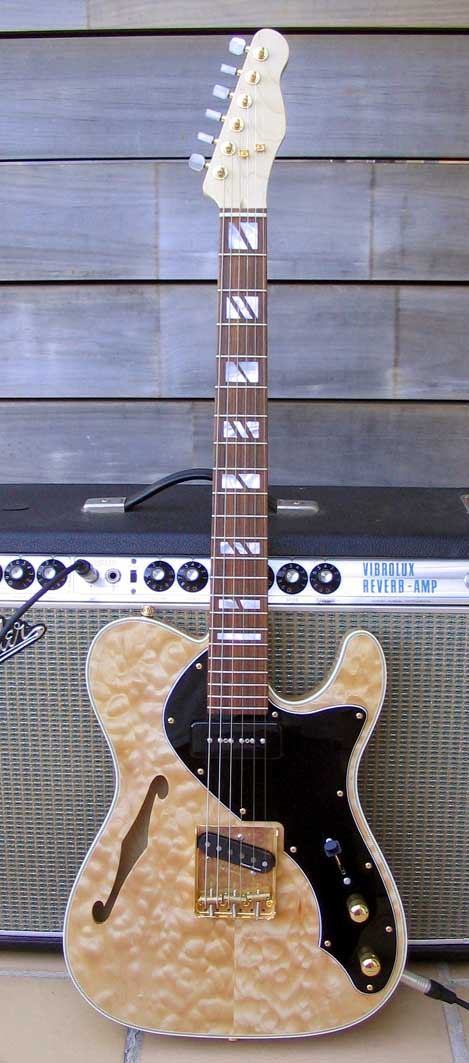
Review and Specs ------------------- I am learning jazz. I also love the look and feel of Teles and have been exploring ways of bringing the two worlds together. For this guitar, my third Thinline partscaster, I have tried to capture some of the features of a Gibson archtop - the P90, the quilted blond top and maple back, the split block inlays, the multi-ply binding and the pearloid tuner keys, but contrasting them with the key Tele features - the shape, vintage bridge, single coil bridge pickup and control arrangement. I went for the short scale neck simply because it makes it easier to play those stretchy jazz chords but I wanted to combine this with a fatter sounding single coil neck pickup. I also have a Les Paul Special HB and an ES345. The pickups are Seymour Duncans - Vintage P90 and Jerry Donahue. They are connected using a four-way switch that gives the three standard options plus the neck pup plus the bridge pup at half-strength. The bridge is a Fender from Angela Instruments. The compensated saddles are from StewMac. The tuners are Gotoh mini-tuners with the Schaller pearloid keys (they do fit). It is very comfortable to play and I am very happy with the sound. I was worried that with all the maple it might sound too bright but this has not proved to be the case.
Robin |
| Darrell |
Vintage Bridge for American Tele's 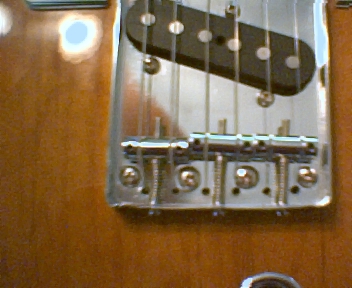 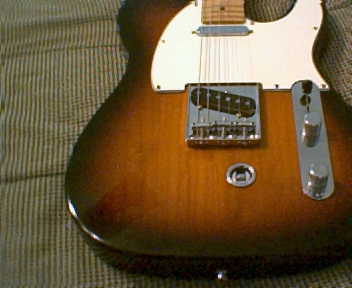 Vintage bridge on AS Tele - the gDarrell modh I came up with this idea a few years ago. But there was a missing link to the puzzle. To have a clean look, you need a vintage bridge with NO string through wholes. I didnft want to have 12 wholes in my vintage bridge. Fortunately, I found one on ebay. Once you find one, you can follow instruction below, and create your own Vintage Bridge for AS Tele. Steps. 1) Remove strings and AS Tele bridge and remove the parts from the bridge. (Move them to one side keeping them in order. Reattach them when you are done) 2) Attach bridge pickup to the Vintage Bridge. 3) Place it on the Tele Body and mark mounting holes. a. These mounting holes will be under the string through wholes b. Make sure that upon marking the mounting holes that the pickup route is concealed on both sides of the vintage bridge. c. Make sure the AS mounting wholes are concealed as well. d. There is zero tolerance, so get it right! If you think there is a tolerance, you are doing it wrong. 4) Use a nail and a hammer and create pilot wholes for the drilling of the mounting screws. 5) Only mount TWO of the mounting screws. Double-check everything (3 a. b. and c.) before moving to step 6. 6) Remove the Vintage Bridge and run a piece of masking tape across the bottom of the vintage bridge where the stringthrough wholes will go. 7) Reattach the Vintage Bridge. 8) Flip the guitar over with the back on top. 9) Mark the string through wholes by using a marker of some type though the string through holes. I use a finishing nail dipped in paint. 10) Flip the guitar over to the front. 11) Remove the vintage bridge. 12) Clamp the AS Bridge to the Vintage Bridge (back side to backside). The string through marks that you painted on would be showing through the AS String through holes. 13) Drill ALL of the wholes before you take the clamps off. Donft bother doing one or two and then looking. You are better off doing them all at one time and getting them straight, than doing one or two, and looking and then trying to realign them and putting the clamps back on. If you ruin the bridge, well you can always get another one for a relatively low cost. But it is better than ruining your guitar. 14) Now you have the finished product. Just attach it and install the other two mounting wholes. The benefits to this mod. 1) You will have a Vintage Bridge looks 2) You will have ferrous bridge dynamics and tone 3) You donft have to get rid of your AS style guitar to get those features. 4) The only mod to the guitar will be the mounting wholes 5) The mounting wholes can be covered and the AS bridge can be put back on. Downside 1) You will have to drill new mounting holes into your guitar. 2) This will be the only Vintage Bridge for your guitar, unless you make another one or use the new bridge as a template for your next vintage bridge. If you want me to create Vintage Bridge unit for AS tele, and donft want to go through the hasslecI will only do this if there is some kind of gdemandh to do it. Like more than 1. I will want a fee, and I will have disclaimers. Darrell 
|
| Katsumi |
Making an aged knob: Since the famous coffee soak or tobacco smoke method can fail depending on a knob's coating material, I tried to "relic" my strat knob using a tint spray and lacquer coating. Here is a BEFORE-AND-AFTER picture. 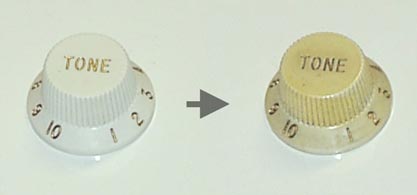 (yes, the direction of the arrow is correct!) I could get this result in less than 30 minutes. Notice the surrounding "grip" on the knob remains sharp. I didn't sand that part on purpose, because I wanted to make this a player-friendly knob. Steps: (1) Sand the knob so that the color firmly sticks on the knob. I sanded it until I did not see any shiny spots. (2) Spray the tint color coat. I used ReRanch's Fender Neck Amber. (3) Add this trick here. I smeared a little bit of pastel powder to get an extra dirty look. I think this is one way of commonly known weathering techniques in the plastic model world. (4) Clear coat the knob with nitro clear lacquer. (5) Then show the knob to your family and friends! Nobody will understand what you are doing. Katsumi |
| Katsumi | |
Read this before you try
Kiwi Shoe Polish application 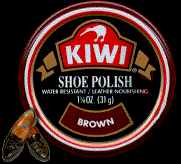 I've personally tested the Kiwi Shoe Polish on my poly-finished neck and found that Kiwi is just a temporary solution for tinting. Yes, it was very easy to apply and it made my whitish neck look like a vintage amber color. Shoe polish is almost like a wax based paint such as Minwax. Basically, wax based paints do not work well when you are constantly touching the surface. It may work great for six months or even two years depending on how often you play the guitar. But the paint will wipe-off especially when your hands are wet from sweating. And nobody knows any side effects since Kiwi is not designed to contact human body. Another bad thing is, generally speaking, it is difficult to apply any top-coat over a wax based paint. So, again, nobody knows if you can successfully build a protective clear coat over the Kiwi wax. PROS: * easy to get a great result in 10 minutes * if it wiped-off in a year, you can just reapply it. (just another 10 minutes job) CONS: * will wipe-off sooner or later * difficult to find a compatible top-coat * nobody knows its side-effects (and you can't sue the shoe polish company if you get sick) Below is a part of MSDS Data Sheet of the KIWI Shoe Polish
here is the complete list |
| Tak Koichi |
| USACG project guitar After reading this website (Japanese version), I decided to built a telecaster using the USA Custom Guitar parts. 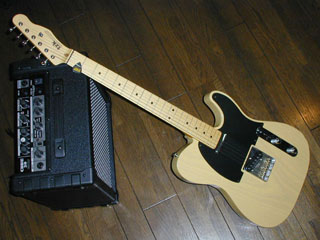 When I placed an order from Japan, I asked Tommy at USACG to make a body and a neck which produced a tone that was bright with long sustain, slightly tight, and heavy but not fat. I know it's very difficult (or impossible) to describe any sound in words but they made a body and a neck which can produce the exact sound I wanted. It's really amazing since in some cases, Swamp Ash Tele turns to be dead-aired fat tone. After playing the guitar several times, I have reached the conclusion that this Tele has turned to be the best guitar out of all of the ones that I own. 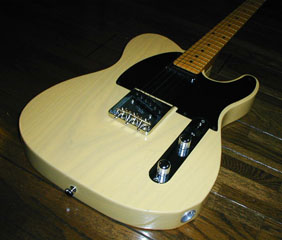 As for the pickups, my original plan was to install Fralin's pickup. But Fralin pickups are hard to get and they are very expensive in Japan. So I put Seymour Duncan's Quarter Pound since I had them already. I thought it might be a mis-match for this guitar but this high output-sensitive pickup could really produce the sound qualities of the characteristics of this neck and body. In Full volume, it is loud, clear, tight and heavy, but not fat. By turning the knob to the left, the sound turns to be sweet and mellow. The sound is great !!! In addition, I found this guitar is very reliable. Especially, tuning stability is excellent. I tuned in a very cold room and then played on very humid and hot stage in a live house. But I did not have to make tuning adjustments. The playability is also good. The neck profile is little bit fatter than I expected. But it is OK. No problem here. Considering the excellence of the tone, fat neck might be better than thin neck to me. The only problem is that this guitar has turned to be the only guitar I play. I think I have to modify my other guitars (Schecter,Fender G&L) to improve their tone. 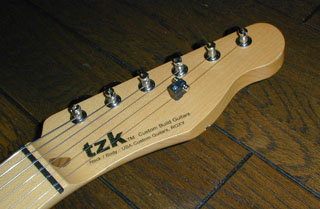 The decal on the head is printed on a KOKUYO Ink jet printer label sheet(film label), using word processpr S/W and Canon BJC-210J(Cheap and old Printer). The surface of the sheet is matte. The finish of the label is excellent. It seems to be a real professionally made brand guitar like ESP or something! Below are the detail specifications of this project guitar ***** USACG Body -Style : T -Wood : Swamp Ash One Piece ( Right Handed ) -Finish : ROXY's Transparent Butterscotch Blonde (06A in Finish Gallery) ***** USACG Neck -Scale : 25-1/2 -Nut width: 1-5/8 -Thickness : .800 -Peg Head : US1 (Right Handed) -Peg Hole : Kluson -Wood : 1/4 Sawn Maple One Piece -Back Contour : C Shape -Truss Rod : Heel Adjust -Fret : 22 -Fret Size : 6230 -Nut Slot : Flat Bottom -Inlay Dots : Black Plastic -Fingerboards : 7-1/4" to 9-1/2" compound radius -Finish : Vintage Tint Stain ***** Pick Up : Seymour Duncan's Quarter Pound ***** Nut : Graphteck Carbon |
| Timothy Ard |
| TELEBASTERD Here is the KISEKAE simulation of the TELEBASTERD 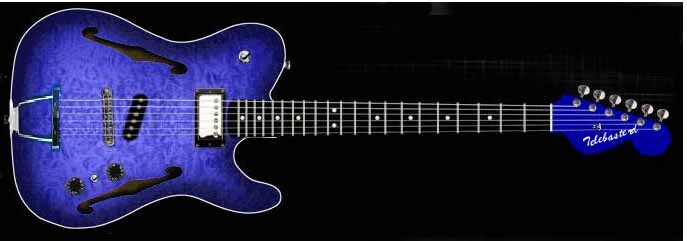
The Telebasterd is done! Some differences from the virtual design are: Black headstock instead of blue. Controls were moved back a bit for playability. 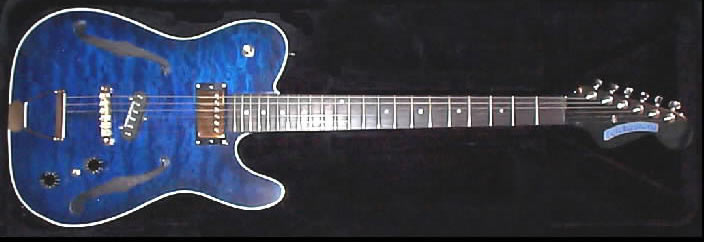 The Official TELEBASTERD Construction site |
| Josh |
| Aging Results - MIM poly maple
neck SHOE POLISH WORKS! 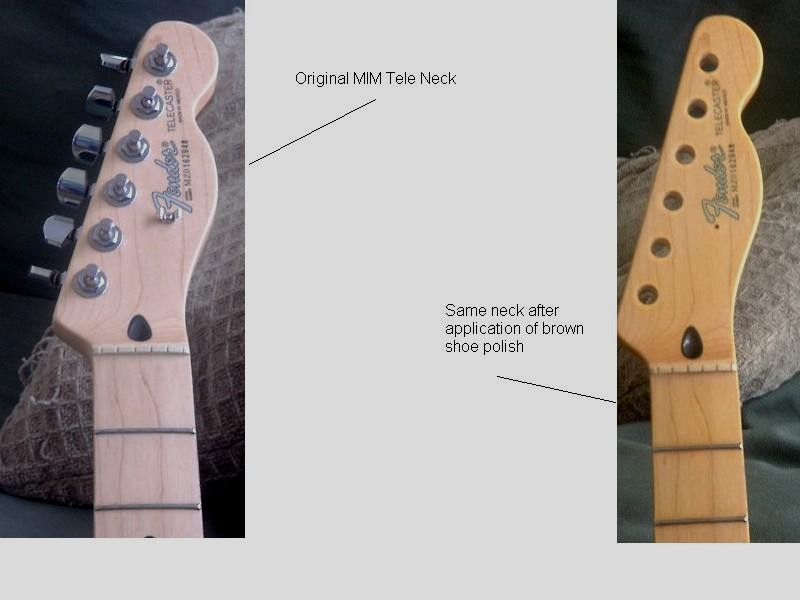 Over lunch I did my Tele neck (2000 model MIM, poly) with the brown shoe polish and it worked perfectly. In fact, I didn't take a picture, but I have a 20-year-old Fender maple neck on another guitar and the 2000 model one tinted with brown shoe polish looks EXACTLY like the 20-year-old maple. I'm thrilled with the result. FWIW, I also buffed the satin finish to higher-gloss with Turtle Wax clear coat polishing compound (done it a bunch on other guitars), to get more of the "vintage" look from my MIM Tele. Do this first. It just takes a few minutes, buff by hand, the result is just like a vintage high-gloss neck. |
| Stike |
Pabstocaster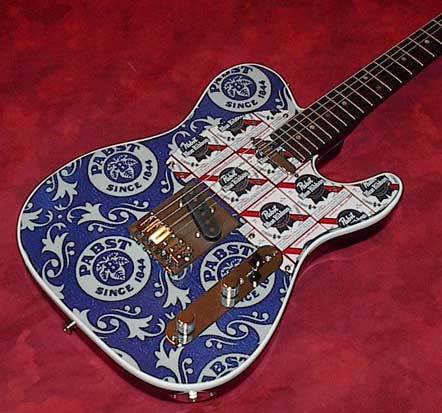 OK. Here's they whole story. First off I collect Pabst stuff, don't why or how it started but I do. I found 4 rolls of NOS Pabst wallpaper on Ebay and bought it with no idea what to do with it. Then I saw a paisley Tele and the so called light bulb went off. The labels on the pickgaurd are adhered with doublestick tape from Stew Mac, that stuff if strong. If anyone is going to do a paisley Tele use this stuff. This stuff stays put wheras I've seen contact cement bubble up reacting with the clear. The labels on the pickgaurd are cleared with 3-4 coats of House of Kolor UFC-1. The body was a nightmare! The wallpaper is flocked meaning that the dark blue is a thick felt like material over the light blue paper so the dark is a few 32nds higher than the light. This resulted in MANY clear coats, definitley more than a sane person would apply. This was also HOK UFC-1. Urethanes can go a lot thicker than nitro but this project without a doubt tested those limits. I wouldn't even consider nitro or acrylic for a project like this, Hell I wouldn't even consider doing it again with anything LOL. The binding was painted. BTW it's an Alder Warmoth body w/ a walnut/ebony Warmoth neck and for all the clear it's surprisingly resonant acousticlly and it really cuts when plugged in. Honestlly I thought it was gonna be just a very labor intensive novelty guitar but I play it out all the time. My band covers Johny Russel's "Red Necks, White Socks, And Blue Ribbon Beer" so I guess I have to. Hope ya'll got a good laugh, I sure did.
|
| Nick Fanis |
| VAN ZANDT TLV60
The TLV60 is a now discontinued VAN ZANDT high end custom tele copy.It has a bound one pc alder body a nitro top,poly undercoat two tone sb finish and KILLER VAN ZANDT true vintage pickups.The guitar is beautifully made with enormous attn to detail and authenticity if the vintage hardware.The neck is a nice medium c with vintage frets very straight and with a nice indian rosewood fretboard.I was very impressed with the quartersawn maple neck.The guitar is light and very resonant and has the woodiest sound of every tele I have ever played.It is now my main guitar.These VAN ZANDT copies are expensive but IMHO better than anything Fender is currently offering. http://photos.yahoo.com/bc/nickfani/lst?.dir=/Mail+Attachments&.view=t |
| -Tonefiend- | |||
| Scott Lentz Tele review by Tonefiend Here is a report of my new Scott Lentz T-Custom. The guitar is the lightest, and most resonant I have ever played. The construction is flawless, and the finish, a 2 tone sunburst is absolutely beautiful. Scott has been making guitars in Southern California for 25 years now, and is at the top of his game. He is well known throughout the states and Europe, and is becoming known in Asia now for the first time. His guitars are works of art. He built it to my specifications. I wanted a tele that sounded aggressive for rock and blues playing, but also sounded like a tele. He nailed it dead on. The pickups were hand wound to match the body weight, and really sound great. The bass notes are deep and crisp, with that tele twang, the highs are chimey and focused. This guitar sounds great all over the neck, and can do it all from lead to rhythm. This thing makes all my amps sound fantastic from the growl of an AC30, to the huge presence and power of my marshall. Played through a brown princeton it has the classic fender sound. Very chimey and sweet, but when pushed hard makes the amp bark. It is rich with harmonics and overtones. The guitar is very lively. I find myself playing it without an amp often because it is so loud. The finish is ultra thin Nitrocellulose Laquer. He has been refinishing vintage guitars for 25 years and it shows by the quality of this guitar. The neck is a nicely aged amber yellow, and has a very smooth silky feel. The fretwork is great. It plays like butter. The body is a beautifully grained piece of Southern swamp ash. He is located in San Marcos California Here are some pic's enjoy them. -Tonefiend-
|
| scott-O-caster |
| Aging Results -
'50s Classic Tele First of all, my thanks to Jim Rumson for the idea and Markophonic for encouraging me to take my white blond 50s Classic Tele to the tanning salon in an attempt at aging but not relic-ing, it. The process had some surprising yet very positive results. Method: First, I used rubbing alcohol to remove any wax/polish/gunky buildup from the finish. My local tanning salon sells time in 20-minute sessions. I bought one session the first night, three sessions the second night, and two sessions the third for a total of 2 hours. I requested the ghottesth tanning bed with the newest lights (they had just been changed). I laid the Tele face down on its strings balanced on a pack of cigarettes to allow it to lay level and elevate it slightly from the glass. Each session I moved the guitar slightly so that the tubes did not shine in exactly the same place each time. None of the surface of the guitar (wood, metal, nor plastic) became hot to the touch, but the wood did radiate some warmth after each session. Results: The first 20-minute session had interesting results. There was very little color change (yellowing) but it had the effect of fading the underlying white paint allowing the wood grain to show through more and enhance that bluish cast that the grain in a white blond has in addition to softening the white just a bit. The second night was for 1 full hour, which resulted in a noticeable, although slight color change. With the pickguard removed, a very subtle gtan lineh was visible and the color of the exposed areas became a softer, warmer off-white. The neck also darkened slightly. The most interesting result occurred when I returned home and plugged the Tele in to find that the sound had changed. The bridge pickup had lost the gice pick in the eardrumh sound but retained all of its former twanginess. It was a subtle change, a bit warmer and fuller than before and noticeably more resonant, even unplugged. I first thought that it might be attributable to the expansion of the wood from the warming, but it retained its new mellower sound even the next day when played cold. My hypotheses are 1) the electromagnetic field generated by the tanning bed had mellowed the pickup magnets, 2) the intense UV and resulting warmth generated by the lights had dried the wood and opened the grain thus enhancing resonance, 3) the transformers in the bed generated high-frequency sound waves that enhanced the resonance or 4) a combination of some or all of the above. Unfortunately, I canft A/B the guitar with itself in its before and after condition, but I know that Ifm not imagining the sound difference. It now sounds nearly identical to my 18 year old f52 RI. The final session (40 minutes) resulted in no sonic or resonance changes but did darken the finish even more. Itfs current color is a creamy Vanilla, about the color of a 5-10 year old white blond Tele. Jim Rumson suggested 2 hours then to let it rest a few days for the chemical reactions to tke place which is where Ifm at now. To sum it up, my experimental attempt at aging the finish resulted in a total aging of the guitar while retaining the like new condition of the finish (other than the color), metal, and plastic parts. In gTime Machineh terms, itfs now a Closet Classic. My goal was not to relic or cosmetically age the guitar, only to soften the color of the white blond. That goal was certainly achieved and more. Thanks, guys for the advice. ==== Jim Rumson A day in the hot sun would cause heat damage to the guitar... the tanning salon is safer. Although I would never have said so, in public, at the time, I also swear that the E/M field of the tanning bed has a positive effect on tone, for a reason I cannot explain. DO NOT OVERDO THE UV, however, or you will start to make the finish very brittle (before its time). I'm really glad you were brave enough to take the advice, and I'm genuinely happy you achieved the desired results! |
| GuitarJonz | ||||
| I
did an aging on my MIM 50s Classic. Heres what I did. Using Kiwi brown shoe polish, wipe polish on the entire body, wait 2 min., then wipe off before it dries. Do this twice. Obviously, remove the pickguad so you won't get any on there. It works excellent, turning the IMO ugly white blonde into perfect late 50s blonde. Mine came out looking exactly like the '58 Tele on p. 37 of the Tele Book. Others said "oh no, it will wipe off, etc", but it stays on there, and no amount of rubbing with a clean white cloth could remove any of it. Just be sure you want it this way, because it seems to be permament. Of course, maybe paint thinner or something could take it off, but I never tried it, as it looked SO COOL!
|
| NickFanis |
| Well there have been some great coments
on the different sound of our favorite axes,so I think I
have to give a report on the subtle but important sonic
differences of my teles. Last night I loaded them with fresh 011 GHS pure nickels and plugged them in my 68 JBL loaded twin reverb.I own 78 ash body,roundlam neck, MIJ 69 Thinline Ri with DIMARZIO Twang Kings and brass saddles and 1962 self made copy alder/ rosewood with intonated brass saddles and Texas Special pups. 1. the 78:this is the best of the bunch IMHO very twangy,snappy and solid sounding,sustain for days and lots of harmonics.The "classic" tele sound.The pups are a bit microphonic with lots of overdrive but I guess that's the reason the axe sounds so good in the first place.Looks great also in a butterscotsch finish.The neck is simply the best feeling neck I have ever played,huge and very comfy (the axe was bought with jumbo frets that add to the sustain and playability). 2. the THINLINE:Very airy sounding,a great soloing instrument,it has more pronounced mids and an overall more civilized character.Amazing built quality for the money and the DM pups really add a lot to the whole package.The neck is thiner than the 78 but feels good too (vintage frets on this one).The axe sounds "meatier" with more mids than the 78. 3. the 62:this is the "overdrive" guitar.The best dirty tele tone ever (I guess Texas Specials love alder and overdrive).More mids than the 78 and less than the thinline,very punchy sounding but it don't twang as much as the other too.Think rock not country.The neck is a bit skiny for my taste with vintage frets and the string spacing is not as comfy as the other two but I got used to it. All in all I think these babies cover pretty much the whole tele sound spectrum:twang,punch,warmth and great harmonics. |
| Reviews from magazines |
| 52RI This model hearkens back to Fender's earliest days when the Telecaster was expected to sound jazzy as well as twangin'. The wiring tells all: The selector's rear position is the front pickup, and the front position is the front pickup with all treble rolled off. This is supposed to give the Tele a dark, arch-top sound. (It sounds very muffled, like Stephen Stills' solo tone on "Wooden Ships.") The '52 features an ash body, non-staggered bridge pickup polepieces, three brass saddles, hip dome knobs, slot-head screws (bummer for the guys on the assembly line), and an orangey, nitro-lacquer finish that's designed to look old. The workmanship on the '52 is quite cool: The thick finish is nearly flawless, and the routing and shaping are reasonably clean. The neck pocket could be tighter, though - it doesn't pass our infamous business card test. (GP cards are .010 thick, and we could slip a .014feeler in the gap.) The control cavity is unshielded it wasn't shielded in '52 either), and cloth-covered wire is used everywhere. The wiring and soldering is tidy. The '52 reissue's neck has a excellent old Tele feel. Too bad the finish has to be so dang heavy. This guitar's got the tone too. It's spanky bite and fat twang are most authentic sounding, and the front pickup - sans capacitor - sounds good and clear. The rear pickup is not squeal-free. Weight: 7lbs 13 oz. Comments: Great Tele tone and vibe. Out of five possible stars as follows. Playability: **** Workmanship: **** Materials: **** Versatility: **** Twang factor: **** Bang for $$$: **** --------------------- 52RI This Telecaster is essentially a snapshot of the electric guitar as it was the day it was born: simple, elegant, and full of beans. Plugging into a new Fender combo, the guitar roared to life on the bridge pickup setting, it's American Vintage pickup retaining all the bite of the traditional Tele, but blissfully lacking any of that howling screech that can make lesser Tele bridge pickups so annoying. The guitar sounded perfectly twangerific in the clean mode, but Teles do or die in the distortion zone. More often than not, they crumble into a sheer sonic mess, but the '52 proved otherwise: it had all the beef of a 'bucker, without losing any of it's Tele appeal. Effortlessly, I was cranking out ferocious power chords and leads with squeling edge of the pick harmonics. And as befitting the Tele's universal popularity, this guitar is good for everything from country to hard rock, thanks to that ripping pickup. It's a classic plank, to be sure. I wish I could say the same kind remarks about the neck pickup, but I found it somewhat underpowered and tonally muted. Although it was bassy enough, the unit was a bit too flat for my taste; I even have reservations about jazz players getting a good tone out of it. As a remedy, however, just go to the middle pickup position and work off the bright edge of the bridge pickup and the fatness of the neck. It's not a perfect solution, but it works. Fortunately, the maple neck plays great and really, few people buy Teles for that front pickup anyway. [Fruther notes Mike Lewis, "This pickup is an exact reproduction of the '52 neck unit. The style of music played back then was different from music today, and the pickup was designed accordingly. Actually, this guitar appeared before the advent of the electric bass, so the neck unit was extremely bassy, for low end comping or whatever. After electric basses arrived, the modern wiring for neck pickups was devised."] Like it's ancestors, this '52 reissue is a workhorse that does the Tele business and then some. Reservations about the neck pickup aside, the '52 Telecaster is certainly not just another dumb blonde. ---------------------- MIJ '69 thinline circa '93 The thinline's semi-hollow mahogany body is a big departure form standard Tele design. Details include a 21-fret, maple on maple neck with wide dot-spacing at the 12th fret, a box tailpiece with a 3-point ssteel bridge and full-round bridge saddles, a mother-of-bowling ball pickguard, Gotoh tuners, a butterfly string tree, flat-top knobs, and standard Tele pickups (the bridge pickup's polepieces are non-staggered). The Thinline is very nicely mad. The neck and fretwork feels excellent, and the clear finish on the natural mahogany body is blemish free and beautiful. Inside the hollow control area we found unshielded pickup wires and a shielded output lead. The soldering is clean. The Thinline is a lightweight and very toneful istrument. The rhythm pickup has some squel problems, and it's muddier and quieter than the lead pickup, but it's beefitness is quite cool. The bridge pickup is very bright, but never sounds too thin. Weight: 7lbs 3oz. Comments: This one has that magic Tele sound. Out of five possible stars as follows. Playability: **** Workmanship: **** Materials: **** Versatility: **** Twang factor: **** Bang for $$$: **** |
| Bob McLeod |
| '50's Classic and an
ash '69 Thinline A Tale of Two Teles: MIM report... I recieved my two new MIM teles from Larry Miletich at Music One. I and a few of my fellow tele-holics have had a chance to work 'em out and here is a short review: Number one is
a '50's Classic, sunburst finish, all stock except for
compensated brass saddles installed by Larry during
setup. Number two is an ash Thinline, also in sunburst. Build
quality and finish just as good as the '50's. Very airy
and open tone - this baby rips! About a 9.5 on the twang
scale. Excellent bass response and sweet, smooth highs. I
expect the brass saddles have something to do with that. |
| Katsumi |
| Fender USA American
Standard (1999 model) Price : about $650 at SamAsh in New York Color : Black I checked about ten guitars when I bought this one. Very distinct trebly sound which anyone can tell it's a Telecaster tone. Especially the center position (bridge + neck pickup) is sooo beautiful! (tears in my eyes!) With this guitar, I can enjoy playing even with no effecters. GREAT! BUT, but! the stock neck PU is "so-so" to me. It's okay and usable but it doesn't sound like a Tele. When I pick the strings hard, then it becomes a little bit twangy. But when I play it with regular picking strength, it sounds more like a Stratcaster. At fast, I thought Tele's neck pickup was always like that and I didn't think there would be better ones. But when I saw a video "PLAYING IN THE STYLE OF THE FENDER TELECASTER GREATS" and heard the sound from Troy Dexter's American Standard neck pickup, I've decided to replace mine. I could copy his bridge and middle sound with my Fender Princeton Chorus amp. But I couldn't reproduce his great neck sound at all. (Does he use stock pup for his neck pu?) The joint part of the neck and the body is very tight and precise. I didn't except the routing cavity of this body was this small (Fig.1). (around 1991, since it goes under the pickguard and nobody can see, Fender put a large cavity called "swimming pool" on the body so that a body can fit any kinds of pickup combinations. The Strat Plus for example, was almost like hollow-body. In my opinion, with the swimming pool and laminant body, Fender's quality was much worse than infamous CBS era.) Fig.1 This body has thin laminant on the top and the back. I don't like it even though this guitar stil sounds great. It is just a matter of my "feeling". I might replace this body in the future. Volume and Tone knobs are plastic. That's okay with me since it makes the guitar lighter and still looks like metal parts. Tuners are made by Schaller. A simple rectangle design. (too simple?) Bridge plate are not firmly attached to the body on some guitars. I noticed some guitars had a little floating space in the rear side, some had space in the front side, and some were firmly attached. Now I think having additional screws on the plate (like Music One, Vintique, etc) is not a bad idea. It is difficult to switch the pickup selector knob once it is in the bridge position since there is too little space between the selector and the volume knob. (I'll change this tip) If you want old tele's
"fat" tone, you should buy 52RI or MIM Classic. Katsumi |
| Kazuhiro Yano | |||
Hello, My name is Yano. I live in
Kagawa-ken in Japan.
This guitar sounds really good! I really mean it! I think this nice sound is
delivered from the thin nitro finish, GraphTech's string
saver, neck adjustment, and the no-stress saddle height. |
| Chipl |
| I had a one meg pot in my 52RI when I
had the stock pickups in it, but when I had the Fralins put in, I found the 1 meg pot made the pickups sound too trebly so I went back to the 250, which worked better. But the 1 meg pot sounded really good with the stock pickups to my ears Chip Lovitt |
| v |
| ModelFFender Japan TL-52 I bought it for about 65000 yen 16 years ago. I don't know what the body material is. Maybe Ash I think. I use it when I want the Rolling Stones' sound. Since it has a lot of wear, it looks like a real vintage now. Color: Blonde (whitish one. I didn't like butterscotch at that time) Modifications: I wanted fatter tone. So, potentiometer 250k -> 500k bridge saddle -> SCHECTER 6way (I cut my hand with its original bridge!) pickup (bridge) -> Tom Anderson (same as Keith Rechards) pickup (neck) -> normal (it already had a great sound) I can't recommend this stock bridge pickup since it sounds too fat and too muddy when I turn up the volume of my amp. Next Projects: I think I'll change the pickup and the pot again. Maybe Voodoo TL50's or Vanzant? Also, I'll try 52's wiring on this guitar. |
| yano@52-80TX |
| I have FenderJapan
TL52-80TXiWhite ash,texas special pups) Duncan quarter pound -> Vanzant true vintage pot -> made in Japan (Japanese Pot size was not the same with USA pot!) switch -> made in USA condenser ->replaced with a larger size Van Zant has less power than the original Texas Special and Duncan quarter pound. It has a clearer tone. I think I've finally found a true tele tone. I also like the bridge pup since it is not too trebly for me. |